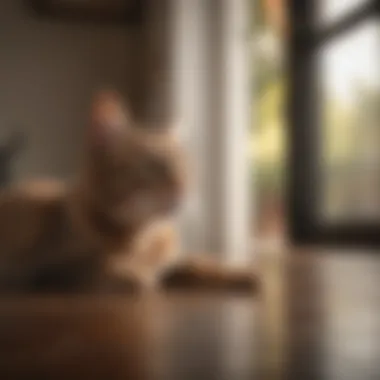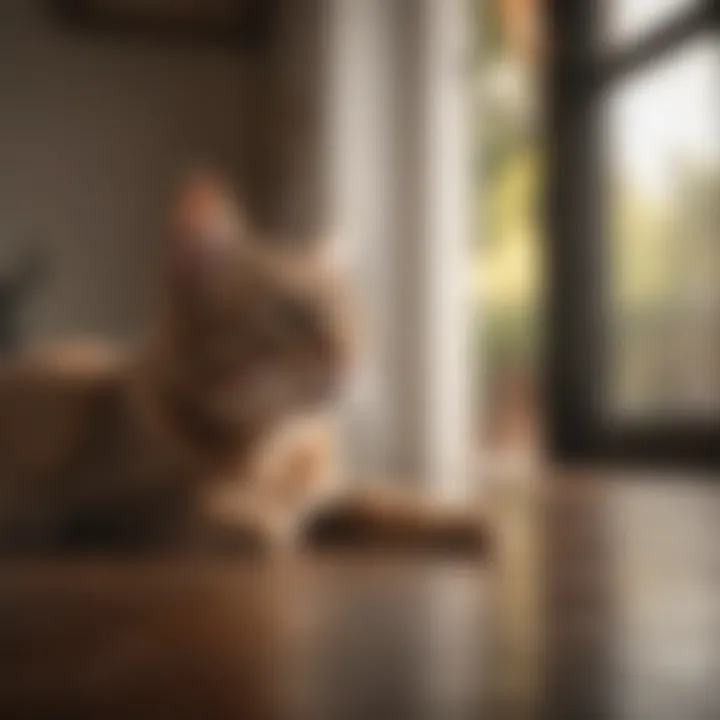Effective Strategies to Prevent Cat Scratching at Doors


Intro
Having a cat can bring immense joy to a household, but it also comes with its share of challenges, one of which is door scratching. It's not just a minor nuisance, but a behavior deeply rooted in the feline nature. Whether it's your wooden entrance door or the slightly less prized bathroom door, the underlying reasons for this behavior can range from boredom to territorial instincts. This introduction aims to shed light on why cats feel the need to claw at doors and offer you a foundational understanding of the behaviors and motivations behind this common feline quirk.
Pet Care and Grooming
Importance of Regular Care
When it comes to your feline companion, regular grooming isn’t just beneficial for their coat; it can also help mitigate scratching behavior. One of the reasons cats scratch is to shed old claws, and if they are well-groomed, they might be less inclined to take it out on your doors. Additionally, establishing a routine creates a bond between you and your pet, making them feel more secure and less likely to engage in destructive behaviors.
Grooming Techniques by Pet Type
Different cats require varied grooming methods. For instance, a long-haired Persian will need daily brushing to prevent mats and tangles, whereas short-haired breeds, like the American Shorthair, can get by with weekly grooming.
- Long-haired cats: Use a wide-toothed comb to detangle and a bristle brush to smooth their fur.
- Short-haired cats: A rubber grooming mitt can work wonders; it stimulates the skin and also helps with shedding.
Tools and Products Recommendations
Investing in proper grooming tools can save you headaches later. Here are some essential items every cat owner should have:
- Cat brushes: A combination of bristle and wire brushes works for most breeds.
- Nail clippers: A good pair of clippers will help keep those nails in check, reducing the urge to scratch.
- Scratch pads: Providing adequate alternatives to scratch can redirect their focus.
Seasonal Care Tips
During colder months, indoor cats may experience dry skin and static. Using a humidifier can help maintain moisture in the air, making your kitty more comfortable and potentially reducing their inclination to scratch surfaces out of frustration.
Health and Nutrition
Understanding Pet Nutrition
A balanced diet is essential for your cat's overall well-being. Poor nutrition can lead to lethargy and a tendency to scratch more frequently out of boredom. Ensure your cat's diet includes plenty of proteins and essential fatty acids to keep them healthy and active.
Common Health Issues by Species
Feline health issues can manifest in different scratching behaviors. Conditions like allergies, skin infections, or even anxiety can lead to an uptick in undesirable scratching. Being aware of these can help you manage their behavior before it escalates.
Preventive Care and Regular Check-Ups
Taking your feline friend to the vet for regular check-ups is crucial. Early detection of any health problems can drastically improve your cat's quality of life and potentially minimize scratching behaviors caused by discomfort.
Food and Dietary Advice
Keep an eye on your cat's weight. An overweight cat may develop health issues, leading to increased scratching or irritability. Consult your vet for dietary adjustments that can ensure your cat remains at a healthy weight.
Behavioral Training
Basics of Positive Reinforcement
Training a cat not to scratch doors can begin with positive reinforcement. When your cat uses a scratch pad instead of the door, reward them with a treat or affection. This method encourages good behavior rather than punishing bad behavior.
Training Techniques Users Can Apply
- Place a scratch pad near the door.
- Use catnip on the scratch pad to draw their interest.
- When they scratch the pad, praise them even if it’s only for a moment.
Managing Behavioral Issues
If you notice signs of stress or anxiety linked to scratching, it might be worth investigating their environment. Is there another pet that's driving them to scratch? Addressing these environmental stressors can help manage their scratching tendencies.
Importance of Socialization
A well-socialized cat tends to have fewer behavioral issues. Introducing your cat to new experiences and environments can make them more adaptable and less prone to stress-induced scratching.
Engaging Activities and Enrichment
Fun Games to Play with Your Pet
Interactive play is essential for cats. Engaging them in regular activities not only helps keep them fit but provides an outlet for their energy. Use feather wands, laser pointers, or even simple balls.
DIY Toys and Activities
Creating DIY toys can be a fun way to enrich your cat's environment. Try making a simple ball out of aluminum foil or a cat puzzle from cardboard boxes. This can provide stimulating fun without the hefty price tag.
Importance of Mental Stimulation
Cats are intelligent creatures who need mental engagement. Providing puzzles or hiding treats around the house can keep their minds sharp. The more stimulated your cat feels, the less likely they’ll resort to scratching as an outlet for excess energy.
Outdoor Adventures and Exploration
Taking your cat for controlled outdoor time can be beneficial. A leash and harness allow your cat to roam a bit without the risk of them darting off. This can open their world and help reduce pent-up energy, leading to less destructive behavior inside.
Resources and Community Engagement
Recommended Books and Websites
There are numerous resources available to further educate yourself on cat behavior and care. Websites like Wikipedia and Britannica are valuable sources.


Forums and Groups for Pet Owners
Engaging with other pet owners can be enlightening. Reddit has various cat-focused communities where you can share experiences or seek advice. Find a group that resonates with your interests and needs, and participate actively.
Finding Local Services and Classes
Sometimes locating the right trainer can make a world of difference. Check online platforms or ask others in your community for recommendations on pet training and behavioral classes.
Encouraging Community Sharing and Contributions
Social media platforms like Facebook host several groups dedicated to pet ownership. Look for local chapters where people share tips, advice, and their experiences with scratching behavior. Sharing your own experiences can also help others navigate similar challenges.
In fostering an environment of understanding and cooperation, pet owners not only enhance their own living space but also create a healthier, happier life for their feline companions.
Understanding Feline Behavior
Understanding feline behavior is essential for addressing the common issue of cats scratching at doors. Recognizing why cats do what they do, especially in terms of scratching, allows pet owners to make informed decisions. Not only does this knowledge contribute to a well-rounded pet care routine, but it also fosters a quieter living space for both human and feline companions. Each element discussed here brings us closer to effective strategies.
Natural Instincts and Scratching
Purpose of Scratching
At its core, scratching serves a vital purpose for cats. They need to maintain their claws and stretch their muscles, but scratching is not just about physical upkeep; it's also tied to instinctual behavior. While humans might see scratches on a door as damage, to a cat, it’s akin to a personal marking; a business card left on a tree or rock. This aspect of scratching stands out, as it’s not solely about keeping claws sharp but about comfort and survival.
The significance of scratching can’t be overstated. It allows cats to communicate invisible boundaries within their environment. Understanding this purpose is crucial because it puts a cat's natural behavior into perspective, helping owners respond appropriately.
Physical and Emotional Benefits
Scratching also boasts numerous physical and emotional benefits. For starters, it's a natural way for cats to relieve tension. After all, these petite predators experience stress just like we do. When cats scratch, they are honing their claws, but they are simultaneously venting pent-up feelings. It's like a good stretch after a long day at work—it feels good and releases pressure.
Moreover, the act of scratching helps to invigorate a cat's muscles. This exercise keeps them healthy and agile. The unique feature of this behavior lays in its dual nature, concurrently catering to their instincts while supporting their physical condition. Recognizing these benefits empowers owners to pursue positive alternatives to unwanted scratching, as managing behavior doesn't mean stifling natural habits.
Why Cats Scratching Doors
Territorial Marking
Territorial marking is a significant motivator behind a cat’s scratching behavior. By scratching, they are not only maintaining their claws but also signalizing other creatures that this space belongs to them. It's a fundamental instinct rooted deep in their DNA. When your cat scrapes at the door, they might be saying, "This is my turf!" Many people find this to be an inconvenience, but the importance of this action is profound in the mind of a cat.
This explanation elucidates why understanding territorial marking is beneficial for owners. Instead of seeing it as a nuisance, it's a window into your cat's psyche. Acknowledging this behavior can help you develop a more balanced approach, where you can provide alternative scratching surfaces that satisfy their need for territory without damaging your doors.
Seeking Attention
Another reason cats scratch doors is that they may be seeking attention. This is especially evident in households where interactions with pets are sporadic. The simple act of scratching can serve as a cry for interaction, urging owners to engage with them. It's a clear signal: if they scratch and you respond, they learn that this behavior garners attention.
The relationship between scratching and attention is fascinating. While it may seem annoying, it highlights the bond between cat and owner—cats are social creatures with a desire for connection. Recognizing this can redirect behaviors in positive ways, allowing owners to establish structured play times or dedicated cuddle sessions, thus enriching their feline's life beyond just scratching at doors.
"Understanding why cats scratch can turn an annoyance into an opportunity for deeper connection."
Assessing Your Environment
When it comes to managing a cat's scratching tendencies, understanding and assessing your environment is paramount. Cats thrive in spaces that cater to their instincts, and by evaluating your home, you can create an atmosphere that naturally reduces the urge for them to scratch doors. Recognizing areas where your feline friend might be inclined to scratch can help you in devising a strategic approach to mitigate this behavior.
Identifying Problem Areas
High Traffic Zones
High traffic zones are often the hotspots for any scratching activity. These are the places in your home that attract the most human traffic—like hallways or doorways that lead to other rooms. The constant movement in such areas can motivate your cat to mark their territory. Their claws, after all, are not just tools for stretching and maintenance; they serve as a communication method. Cats instintively engage in scratching where they see or sense activity.
One key characteristic of high traffic zones is visibility. When cats scratch these visible areas, it draws attention to their presence and asserts their marking behavior. However, this can lead to unwanted damages to doors and walls, which is certainly not ideal for homeowners. A unique feature of high traffic zones is their potential for deterrence. Redirecting your cat's attention to scratching posts placed strategically in these areas can divert their focus and ease the scratching habit. It's a combined effort that can yield substantial benefits, fostering a more harmonious living arrangement.
Visible Scratching Patterns
Visible scratching patterns provide crucial insights into your cat's behavior and emotional state. If you notice specific locations where scratch marks are frequent, these patterns can be likened to a map of your cat's territory. Understanding these scratches can help greatly in curbing unwanted behavior.
Elements like the depth and frequency of scratches can indicate stress or frustration, key aspects to consider when looking for solutions. It’s fascinating that visible scratching is also very beneficial as it allows you to pinpoint the exact areas that may require attention. Rather than simply covering up scratches or ignoring the signs, taking a proactive stance with this information can facilitate better long-term solutions. This unique feature of recognizing patterns prompts the need for re-evaluating your spaces, making it easier to identify appropriate outlets for your cat's scratching needs.
Evaluating Available Space
Access to Climbing Structures
Access to climbing structures is another critical aspect to consider. Cats are natural climbers, and providing them with ample opportunities to reach higher ground can alleviate scratching at lower surfaces, such as doors. Having vertical spaces like cat trees or shelves directs their energy upwards and encourages exploration, which is vital for their mental enrichment.
A key characteristic of these climbing structures is that they offer a sense of security and entertainment for the cat. With more enriching spaces, your feline companion is less likely to engage in destructive behaviors at the door. This presents a beneficial choice for cat owners looking to mitigate door scratching while nurturing their cat’s adventurous spirit. So, ensuring your home has adequate climbing structures isn’t just about aesthetics; it’s a necessary adjustment for a balanced environment.
Availability of Scratching Posts
The availability of scratching posts can’t be emphasized enough in creating a cat-friendly home. Scratching posts come in various designs, materials, and sizes, and should be placed in locations that are convenient for your cat to access. An essential characteristic of these posts is that they offer a designated area for your cat to indulge its natural scratching instinct.
Having scratching posts scattered around the house means your cat has alternative places to scratch, thus reducing their inclination to target doors. The unique feature of scratching posts is that they often come with added benefits, such as being engineered to provide a stable structure that withstands vigorous scratching. However, one drawback might be that not all cats take to them immediately, requiring a bit of time and positive reinforcement.
In summary, assessing your environment is the first step toward creating a scratching strategy that benefits both you and your pet. Once you identify problem areas and evaluate the space, you set the stage for implementing effective solutions to manage your cat’s scratching behavior.
Implementing Preventive Measures
Mitigating cat scratching at doors is not just about dealing with a nuisance; it’s about understanding and addressing underlying behaviors. Implementing preventive measures can significantly reduce the likelihood of this behavior, leading to a happier home for both cats and their owners. These measures involve creating appropriate outlets for scratching as well as introducing deterrents that will protect your doors and other furniture.
Creating Dedicated Scratching Areas


Creating dedicated scratching areas inside the home is vital for redirecting your cat's urge to scratch towards more suitable surfaces. This approach recognizes that scratching is an instinctive behavior and presents alternatives that fulfill this need.
Recommendations for Placement
When selecting the placement for scratching areas, consider the natural behavior of cats. Cats tend to scratch in areas where they feel most comfortable and confident. Choosing spots that are near their favorite lounging areas or play zones is ideal. The key characteristic here is accessibility; if the scratching post is inconvenient, the cat may ignore it.
A unique feature of recommended placement is ensuring visibility from common areas. Cats are social animals, and if they can see their scratching post while being near you, they are more likely to use it. This can also help in developing a bond over shared activities like playtime. However, one must be cautious; if a scratching post is placed in a high-traffic area, it might become a source of stress for the cat, defeating the intended purpose.
Types of Scratching Posts
Now, let’s discuss the various types of scratching posts available. It is essential to choose one that suits your cat's preferences and your household's layout. Most commonly, you have vertical posts, horizontal ones, and even those that resemble trees. The advantage of vertical posts is that cats like to stretch while scratching, which helps to keep their claws in good condition.
The unique feature of scratching posts is their materials; they come in different fabrics, from sisal rope to cardboard. These different textures can cater to varying scratching habits. For instance, natural materials like sisal are often popular because they mimic the feel of tree bark, giving cats an appropriate option for scratching. A disadvantage to consider is durability; some cheaper options might wear out quickly, leading to frustration for both pet and owner.
Using Deterrents Effectively
In tandem with creating scratching areas, using effective deterrents can significantly manage unwanted scratching behaviors at doors. This dual approach is key to fostering a balanced living environment where both the cat's needs and the owner's preferences are respected.
Physical Barriers
Implementing physical barriers such as door covers or vinyl sheets can act as a first line of defense. These barriers are intended to prevent access by making scratching difficult or unappealing. The key characteristic of these physical barriers is their straightforward application; some may simply adhere to the door while others need to be mounted more securely.
A unique aspect of physical barriers is that they can be combined with other techniques, enhancing effectiveness. However, while they certainly help in protecting the door itself, a drawback is that they do not address the root cause of scratching behaviors, which means they should be used alongside educating your cat on proper scratching behavior.
Scent and Texture Deterrents
Lastly, scent and texture deterrents can be a useful tactic for keeping cats away from doors. Cats have a strong sense of smell, so using smells that they find unpleasant—like citrus or vinegar—can effectively discourage them from approaching certain areas. The texture aspect involves applying sticky tape or other unpleasant surfaces on the areas they target for scratching.
The chief advantage of using scent and texture deterrents is that they are non-intrusive; they do not require any major changes to the environment. A consideration here is monitoring effectiveness; some cats might adapt over time regardless of the deterrent used, so it’s essential to have multiple strategies ready.
"Preventing scratching isn't just about avoiding damage; it's about understanding what drives the behavior in the first place."
By combining these preventive measures, cat owners can create an environment that's conducive to positive scratching behavior while protecting their space from damage. This approach not only enhances the living environment for both pets and owners but also fosters a harmonious coexistence.
Training Techniques for Cats
When dealing with the common issue of cats scratching at doors, the role of training techniques cannot be overstated. Training isn't just about teaching tricks; it's about fostering a better understanding between you and your feline companion. The right strategies can drastically improve the dynamics of your home by encouraging appropriate scratching behavior while redirecting their instinctual urges away from your doors.
Positive Reinforcement Strategies
Rewarding Preferred Behavior
This method emphasizes encouraging behaviors you wish to see more of—like scratching on designated surfaces instead of your doors. Rewarding preferred behavior turns training into a fun activity. Practically, you can use treat-based rewards or verbal praises to celebrate your cats when they engage with their scratching post instead of the doorframe.
A key characteristic of this strategy is its reliance on positive feedback, which tends to make training less stressful overall for both the pet and owner. When a cat knows it will receive a reward for a preferred action, the likelihood of repeating that action increases significantly. Its effectiveness lies in the fact that it aligns with a cat's natural behaviors, keeping their spirits high.
However, one unique feature of rewarding preferred behavior is the requirement for the owner to be vigilant. This might entail a degree of effort in monitoring the cat’s actions and timing the rewards effectively. It’s a beneficial approach, though sometimes it can be challenging, especially with cats that are used to scratching out of habit.
Consistency in Training
Being consistent in your training will directly impact how well the techniques are received. Cats thrive on routine, so delivering training at predictable times can help reinforce the desired behaviors over time. Consistency helps your cat understand what's expected of them, greatly contributing to effective training outcomes.
A standout characteristic of this approach is its simplicity. By applying the same commands and rewards every time, confusion is minimized. This makes it a popular choice among pet owners who want clear, logical frameworks for their cats to follow. Additionally, this method fosters a stronger bond, as your cat learns to trust your cues.
The unique feature here is that inconsistency can lead to mixed signals. If you reward scratching at a post one day and ignore it the next, it can confuse your pet and complicate future training. This is where commitment from the owner is essential, making consistency a slightly demanding strategy, yet ultimately rewarding for both cat and caregiver.
Redirecting Scratching Behavior
Redirecting scratching behavior essentially focuses on providing alternative outlets for your cat's natural instincts. This method is about shifting their focus from undesirable areas to preferred spots.
Use of Toy Alternatives
Finding alternatives is often a straightforward solution. Offering various toy options can significantly change how your cat expresses its need to scratch. Instead of the door, a well-placed scratching toy can draw their attention and keep their claws entertained. It’s vital to consider variety, as not all cats respond to the same toys.
A key characteristic of this strategy is that it adheres to the principle of diversion. Rather than strictly reprimanding undesired behavior, you’re leading your cat to an appropriate substitute. A unique aspect of this approach lies in its dual function — toys like scratching pads can both satisfy their scratching instinct and promote playful interactions.
While this method is beneficial, the downside is that you'll need to constantly experiment with different types of toys until you find one that truly appeals to your cat. This can involve some trial and error, which might be time-consuming but tends to pay off in the end.
Interactive Play Instead of Scratching
Encouraging interactive play is another way to steer your cat away from scratching doors. When a cat engages in regular, stimulating play with its owner, its need for scratching to release pent-up energy can diminish. Interactive play involves using toys that require mutual participation between both you and your cat.
This method tends to be highly effective because it not only distracts from undesirable scratching but also helps strengthen the bond between you and your cat. A notable characteristic here is its capacity to provide physical and mental stimulation, serving as a better outlet for all that feline energy.
An advantage of this technique is that it can reduce stress and boredom — two common triggers for door scratching. However, one of the drawbacks is that this requires time and commitment from the owner, which can sometimes be difficult in a busy lifestyle.
Using effective training techniques opens up pathways for better understanding with your pet, rendering a more peaceful coexistence within your home.
Grooming and Care Considerations
Grooming is a crucial aspect of maintaining your cat's well-being and can significantly influence their scratching behavior at doors. When pets are well-groomed, their overall health improves, leading to less anxiety and frustration which translates into more manageable scratching habits. Moreover, proper grooming not only keeps the cat's claws in check but also impacts their skin health and behavior, making this area worth exploring in-depth for cat owners looking to create a harmonious living environment.
Maintaining Claw Health
Regular Nail Trimming


Regular nail trimming is a fundamental practice for cat owners. By keeping your cat’s claws trimmed, you can reduce the potential damage inflicted on doors and furniture. It's essential to highlight that trimming encourages healthy claw growth and minimizes the risk of injury to the cat and its human companions. In particular, lightly trimmed claws are less sharp, so any scratching becomes less destructive.
There’s also a psychological benefit to trimming nails: it can help reduce your cat’s tendency to scratch inappropriately. Felines usually resort to scratching when they feel their claws need maintenance or when they are being overly stimulated. Keeping claws trimmed can be seen as a form of preventive care that addresses not just physical needs but behavioral ones too.
One unique feature of regular nail trimming is the ability to ease your cat's stress. Cats are instinctively wary of anything that changes their environment, and if they feel their claws are causing tension—either from snagging on surfaces or hurting themselves—they might resort to more aggressive scratching. In this way, regular trimming helps alleviate that stress, contributing to a calmer, happier animal.
Products for Nail Care
When it comes to cat nail care products, there’s a wide array of tools available to the conscientious pet owner. From clippers specifically designed for cat claws to nail grinders that file the nails down smoothly, these tools can be valuable assets in managing your cat's claw health. The right product choice is essential for ensuring your cat is comfortable during the grooming process.
Nail grinders, in particular, have gained popularity among cat owners because they not only trim but also polish the nails, avoiding the sharp edges left by standard clippers. These grinders can reduce anxiety for some cats, as they often do not produce the same quick sensation that accompanies clipping.
Additionally, there are nail caps available, which can be glued onto the claws to prevent scratching damage. This option provides a more long-term solution to the common issues of scratching while being safer for both the feline and the furniture.
However, it’s vital to choose products carefully, as some may not be suitable for every cat's temperament or might require supervision. Certain brands have garnered good reputations in cat nail care, making it easier to find a fitting solution. Overall, products for nail care can enhance a cat owner's arsenal for managing scratching behaviors effectively.
Bath and Skin Care
Understanding Skin Conditions
Cats, like humans, can suffer from various skin conditions that may contribute to annoying behaviors like scratching at doors. Understanding these skin conditions is vital because they lead the cat to seek relief by scratching, which can escalate into a habit.
Among common skin conditions are allergies, parasites like fleas, and dermatitis, as well as other disorders that can affect the skin's health. Being aware of these factors enables a responsible owner to address the root cause of the scratching rather than just the symptoms. For instance, if a cat is scratching excessively due to fleas, addressing the infestation is more effective than simply managing their scratching behavior with training.
Focusing on skin health not only directly impacts scratching, but it also benefits your cat's overall well-being. Ensuring a cat has a healthy coat through regular baths and appropriate skincare routines can alleviate discomfort associated with skin conditions and, by extension, reduce the urge to scratch insensitively at doors or other improper surfaces.
Impact of Grooming on Behavior
The impact of grooming extends beyond just physical looks; it significantly influences behavioral aspects as well. Regular grooming sessions help build bonds between the owner and the pet, fostering a feeling of security and trust.
It’s important to remember that cats are sensitive creatures. A grooming routine can serve as a calming ritual that helps reduce anxiety or stress. When a cat feels secure in their environment, they are less likely to engage in destructive scratching behaviors. Regularly handling and grooming a cat can contribute to a more relaxed demeanor altogether.
Conversely, inadequate grooming can lead to behavioral issues, as discomfort from matted fur, dirty skin, or long claws may cause agitation and frustration. Such a state can encourage a cat to scratch at doors in an attempt to relieve discomfort. In this light, grooming acts as a preventative measure against unwanted behaviors, enhancing the overall living environment.
Grooming is not just about looks; it's about health, behavior, and emotional balance for your pet.
In summary, understanding grooming and care considerations opens a door to better pet management, contributing positively towards less destructive scratching rooted in both health and behavior. By maintaining claw health and ensuring personal hygiene, not only do we cater to our cats' needs, but we also create a more peaceful atmosphere in our homes.
Long-term Solutions and Considerations
Addressing cat scratching at doors isn't just a quick fix; it requires a thoughtful approach to create a sustainable solution. Ignoring this issue could lead to increased frustration for both pet and owner, jeopardizing the harmony of your shared living space. Therefore, exploring long-term strategies is essential to not only reduce scratching but also to understand and cater to your cat’s intrinsic behaviors.
One key aspect of long-term solutions involves evaluating stress factors that might be contributing to this behavior. It's imperative to recognize that a cat’s scratching is often a response to environmental cues or emotional states. Addressing these root causes can significantly help in curbing unwanted scratching habits.
Evaluating Stress Factors
Environmental Changes
When it comes to the environmental changes, understanding how they influence your cat's behavior is crucial. Cats are creatures of habit, and abrupt shifts in their surroundings can lead to anxiety, which often manifests as more aggressive scratching. This category might include anything from a recent move to the re-arrangement of furniture.
The unique characteristic of environmental changes is their capacity to trigger stress-induced responses. For instance, a new sound from construction outside or unfamiliar scents from visitors can cause your cat to feel unsettled. This makes environmental changes a beneficial focus in your efforts because recognizing and adapting to these shifts can help you stabilize your home for your feline friend. However, one has to be cautious about over-correcting changes since that might further exacerbate anxiety. Balancing stability with occasional variety in their environment is often the key.
Introducing New Pets
Bringing a new pet into the household can significantly increase stress levels for existing cats. This introduction is one of the more common pitfalls that can lead to scratching at doors as a way for the cat to express discomfort with the changing dynamics. New pets, whether they are cats, dogs, or even small animals, alter a cat's perception of their territory, and their instinct is to re-establish that territory through scratching.
This topic is particularly relevant because of the challenges associated with integration. Cats have a natural inclination to protect their space and introducing a new creature can feel like invasion to them. The unique factor here is that the introduction process can be moderated with techniques such as slow introductions and monitored interactions. While it may take time for both parties to adapt and adjust, the end result can create a more peaceful coexistence.
Seeking Professional Guidance
Deciding to involve professionals can often save you from long-term heartaches associated with scratching. For many, this may feel like a last resort, but consulting experts can bring valuable insights that are tailored to your specific situation.
Consulting Veterinarians
One of the foremost steps in seeking professional guidance is consulting veterinarians. These healthcare professionals are not only equipped to assess physical health but can also provide advice on behavioral issues related to scratching. Their perspective is important since certain medical conditions can manifest as disruptive behaviors.
By relying on their expertise, cat owners can benefit from a thorough understanding of what might be causing certain stressors that lead to scratching. The uniqueness of veterinarians lies in their comprehensive approach—balancing physical health with behavioral observations. However, it's wise to keep in mind that in some cases there might be a charge associated with consultations, but the potential insights gained can be invaluable.
Behavioral Specialists
Engaging with behavioral specialists presents yet another layer of support for cat owners grappling with scratching. These professionals dedicate themselves to studying animal behavior and can assist in pinpointing triggers that might not be immediately obvious. Their methods may include behavioral therapies or environment modifications tailored explicitly for your cat, paving a clearer path toward resolving scratching issues.
The distinguishing feature of behavioral specialists is their focus on long-term training strategies that promote positive behaviors over time. While their services might come at a cost, many pet owners find the investment pays off through improved relationships and a reduction in destructive behaviors.
In summary, adopting these long-term strategies can help mitigate cat scratching at doors effectively. By evaluating stress factors, understanding environmental shifts, and seeking professional guidance, you'll be laying the groundwork for a peaceful and harmonious home. Remember, every cat is unique, and adapting these strategies to fit the personality of your feline companion is crucial.
Finale: Crafting a Harmonious Home
Creating a peaceful living environment is not just about avoiding cat scratches on doors, but it’s an essential aspect of fostering a well-adjusted and happy pet. Scratching is an instinctual behavior for cats, reflecting their natural tendencies, whether it's to keep their claws in check or to mark their territory. Therefore, understanding these aspects and effectively managing them is paramount. Combining knowledge of feline behavior with thoughtful modifications in our own living spaces can lead to a harmonious coexistence.
The Importance of Understanding Feline Needs
At the heart of mitigating scratching at doors lies the recognition of what your cat truly needs. By providing suitable alternatives, like scratching posts or pads in accessible spots, you can redirect their tendencies. This approach not only satisfies their need to scratch but also minimizes damage to your home. Ultimately, it reflects a commitment to your pet’s well-being and fosters trust in your relationship.
"Understanding a cat’s behavior is as crucial as providing a comfortable space for them. Both go hand in hand in ensuring a peaceful home."
Benefits of a Well-Structured Environment
Implementing strategies to reduce door scratching can also have additional perks:
- Reduced Stress: A cat that can express itself appropriately will feel more secure and less anxious.
- Preserved Home Aesthetic: Avoiding scratches on doors helps maintain the aesthetic appeal of your living areas.
- Better Interactions: When frustration due to destruction is lessened, interactions between you and your cat can become more enjoyable.
In terms of logistics, integrating products like pheromone diffusers can calm anxious pets, thus reducing the likelihood they’ll resort to door scratching as a form of stress release. Such tools help create an environment that caters both to physical and emotional needs.
Holistic Approach to Pet Care
Taking a step back, fostering harmony in a shared home is about more than just physical modifications. Continuous education—for both you and your beloved pet—on behavioral training, grooming, and environmental enrichment is essential. This is a holistic approach where every piece, from suitable scratching alternatives to routine veterinary check-ups, contributes to a well-rounded solution.
Ultimately, crafting a harmonious home takes time, patience, and understanding. By prioritizing your feline friend’s needs while maintaining your own living space, you create a balanced environment that serves everyone. Engaging with your pet in ways that respect their instincts leads to a deeper bond, mutual respect, and a smoother daily life. Remember, a happy cat is a scratched-free cat—and an overall joy to have around.















